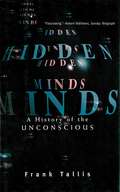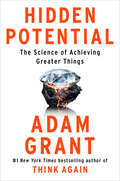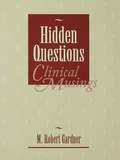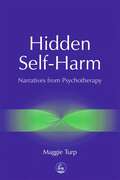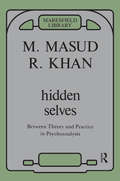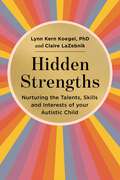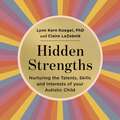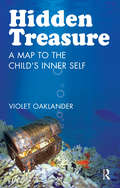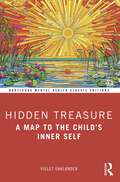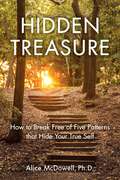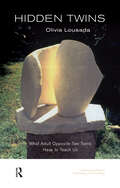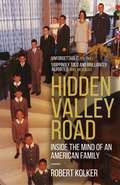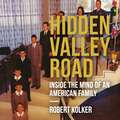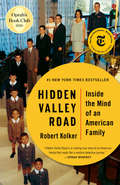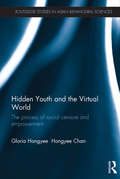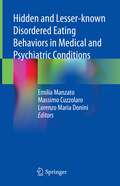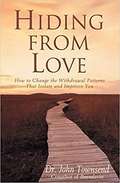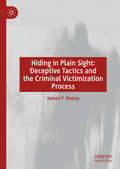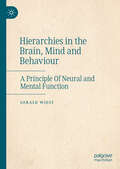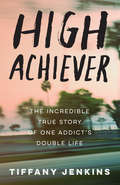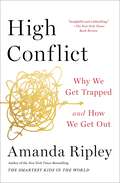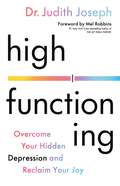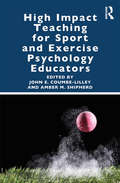- Table View
- List View
Hidden Minds: A History of the Unconscious
by F. R. TallisThe concept of the unconscious has staged a comeback. New research, employing brain scans and other techniques, has shown that the unconscious is not only real but indispensable. Hidden Minds traces our enduring fascination with the unconscious and our attempts to tame it through hypnosis, psychoanalysis, subliminal manipulation, lucid dreams, and even the principles of the quantum mind. From St. Augustine, who wrote, "I cannot grasp all that I am," to the latest contemporary research, philosophers, scientists, and thinkers have been fascinated with the concept. This absorbing history offers colorful, sometimes astonishing examples, while also laying out the functions of the unconscious process in our daily lives. Drawing widely on scientific research, art, literature, and philosophy, Frank Tallis shows that an understanding of this hidden mind is essential to understanding our true selves.
Hidden Potential: The Science of Achieving Greater Things
by Adam Grant#1 New York Times Bestseller&“This brilliant book will shatter your assumptions about what it takes to improve and succeed. I wish I could go back in time and gift it to my younger self. It would&’ve helped me find a more joyful path to progress.&” —Serena Williams, 23-time Grand Slam singles tennis championThe #1 New York Times bestselling author of Think Again illuminates how we can elevate ourselves and others to unexpected heights.We live in a world that&’s obsessed with talent. We celebrate gifted students in school, natural athletes in sports, and child prodigies in music. But admiring people who start out with innate advantages leads us to overlook the distance we ourselves can travel. We underestimate the range of skills that we can learn and how good we can become. We can all improve at improving. And when opportunity doesn&’t knock, there are ways to build a door.Hidden Potential offers a new framework for raising aspirations and exceeding expectations. Adam Grant weaves together groundbreaking evidence, surprising insights, and vivid storytelling that takes us from the classroom to the boardroom, the playground to the Olympics, and underground to outer space. He shows that progress depends less on how hard you work than how well you learn. Growth is not about the genius you possess—it&’s about the character you develop. Grant explores how to build the character skills and motivational structures to realize our own potential, and how to design systems that create opportunities for those who have been underrated and overlooked.Many writers have chronicled the habits of superstars who accomplish great things. This book reveals how anyone can rise to achieve greater things. The true measure of your potential is not the height of the peak you&’ve reached, but how far you&’ve climbed to get there.
Hidden Questions, Clinical Musings
by M. Robert GardnerIn Hidden Questions, Clinical Musings, M. Robert Gardner chronicles an odyssey of self-discovery that has taken him beneath and beyond the categoies and conventions of traditional psychoanalysis. His essays offer a vision of psychoanalytic inquiry that blends art and science, a vision in which the subtly intertwining not-quite-conscious questions of analysand and analyst, gradually discerned, open to ever-widening vistas of shared meaning. Gardner is wonderfully illuminating in exploring the associations, images, and dreams that have fueled his own analytic inquiries, but he is no less compelling in writing about the different perceptual modalities and endlessly variegated strategies that can be summoned to bring hidden questions to light. This masterfully assembled collection exemplifies the lived experience of psychoanalysis of one of its most gifted and reflective practitioners. In his vivid depictions of analysis oscillating between the poles of art and science, word and image, inquiry and self-inquiry, Gardner offers precious insights into tensions that are basic to the analytic endeavor. Evincing rare virtuosity of form and content, these essays are evocative clinical gems, radiating the humility, gentle skepticism, and abiding wonder of this lifelong self-inquirer. Gardner's most uncommon musings are a gift to the reader.
Hidden Self-Harm: Narratives from Psychotherapy
by Maggie TurpThis practical and accessible book of case studies takes a new look at self-harm, focusing particularly on the under-explored area of `hidden' self-harming behaviour. These behaviours may not be immediately identifiable as self-harm by counsellors, therapists or their clients, but Maggie Turp shows how recognition and understanding of hidden self-harm can improve practice with those affected. The author begins by discussing extracts from infant observation studies that reflect on the role of maternal care in encouraging the tendency towards self-care. A series of detailed case studies follows, including a client who has a serious eating disorder, a client who abuses recreational drugs, works excessively to the detriment of his mental and physical health and sustains a series of unconsciously invited 'accidents', and one caught up in 'self-harm by omission', who fails to 'take care' and delays seeking vital medical care. The clinical accounts highlight the importance of attending to the client as a whole person and of building on the self-caring tendency that has prompted him or her to seek help in the form of counselling or psychotherapy. Written from a psychoanalytic perspective, but using straightforward language, Hidden Self-Harm is a valuable resource for social workers, psychologists, teachers, nurses and lay helpers as well as for counsellors and psychotherapists.
Hidden Selves: Between Theory and Practice in Psychoanalysis
by Masud KhanThe 'hidden selves' that Masud Khan reveals to us in this third volume of his psychoanalytic writings are to be understood in two ways. Primarily, they are those aspects of the self which are inherent in, but unsuspected by, the individual concerned, and which need to be identified if that individual is to achieve a full and healthy self-awareness. More broadly, they are the ingredients of human nature which may not be evident on the surface but which can be brought out through literature or art, for example, or through the insights gained in psychoanalysis. In analysis, and over a period of time, both analyst and patient discover parts of their personality that were unknown to each other at the start. The person is not just a single 'self' but a collage of hidden selves; and one of the goals of psychoanalysis is to find out how this collage functions for the individual concerned - whether through symptomatology or through introspection.
Hidden Strengths: Nurturing the talents, skills and interests of your autistic child
by Claire LaZebnik Lynn KoegelA groundbreaking, long overdue book that explains how to identify your autistic child's strengths and abilities and then use them as a tool for social communication, improved learning, and overall growth.The strengths of children and young adults diagnosed with ASD are commonly overlooked, even by trained professionals. Outdated attitudes, lack of sufficient training and an overreliance on standardised testing works against recognising their capabilities.Focusing on the importance of motivation strategies, Hidden Strengths shows you how to build on every autistic child's interests and strengths. Through real-life stories of individuals whose innate abilities blossomed once they were acknowledged, this book dispels unhelpful stereotypes and will help you unlock your child's potential. It also aims to educate the wider community in how to support, accept and embrace the gifts autistic individuals offer. 'Will help both parents and teachers find and develop a child's unique skills in memory, music, math, art, and attention to details. Development of these skills can lead to both a more rewarding life and possible careers' Temple Grandin, PhD, New York Times bestselling author
Hidden Strengths: Nurturing the talents, skills and interests of your autistic child
by Lynn Kern Koegel Claire LaZebnikA groundbreaking exploration of the ways in which the intelligence and abilities of children and young adults with autism are often overlooked and misjudged, with tried-and-true interventions that can be used to help them reach their full potential.In Hidden Strengths, Dr. Lynn Kern Koegel and Claire LaZebnik explore how the strengths of children and young adults diagnosed with ASD are commonly overlooked or misjudged, even by trained professionals. The authors examine how outdated attitudes, a lack of sufficient training and an overreliance on standardised testing works against efforts to see the capabilities of autistic children. Focusing on the importance of motivation strategies, Hidden Strengths dives into ways to use a child's interests and strengths when teaching them. The book also aims to educate the larger community in how to support, accept and embrace the gifts autistic individuals offer. Hidden Strengths works to combat established negative and untrue stereotypes about autistic children by using real-life stories of individuals with ASD who were capable of far more than the adults around them realised, and whose innate abilities blossomed once they were acknowledged and encouraged.(P) 2023 Quercus Editions Limited
Hidden Treasure: A Map to the Child's Inner Self
by Violet OaklanderHidden Treasure is a follow up to Oaklander's first book, Windows To Our Children. Most of the books available in working with this population are written from a traditional 'play therapy' point of view. The Gestalt Therapy-based approach provides a more effective method for psychotherapeutic work with children of all ages. The focus is on the relationship between the therapist and client, rather than observation and interpretation. It is a vigorous, dynamic approach.Violet Oaklander uses a wide variety of creative, expressive and projective techniques in her work, and each chapter reflects and exemplifies the use of this work in the service of therapy. The approach is applicable to a wide variety of ages, as well as individual, family and group settings. The book will interest child and adolescent psychotherapists, psychologists, social workers, counselors, interns, school personnel as well as graduate-level students. Parents may also find it helpful, as well as adults who are interested in the child within.
Hidden Treasure: A Map to the Child's Inner Self (Routledge Mental Health Classic Editions)
by Violet OaklanderThis classic edition of Violet Oaklander’s groundbreaking book presents her pioneering approach to engaging with children who enter therapy. A new introduction by Peter Mortola reflects on the ways that Hidden Treasure continues to inform therapeutic practice all over the world. Most of the literature available on working with children is written from a traditional `play therapy’ point of view; the Gestalt therapy-based approach detailed here provides a more effective method for psychotherapeutic work with children of all ages. With a focus on the relationship between the therapist and the client, Violet Oaklander shows a wide variety of creative, expressive, and projective techniques in her work, and each chapter reflects and exemplifies the use of this work in the service of therapy. This dynamic approach is applicable to a wide variety of ages as well as individual, family, and group settings. This book will interest child and adolescent psychotherapists, psychologists, social workers, counsellors, school personnel, and parents, as well as graduate students.
Hidden Treasure: How to Break Free of Five Patterns that Hide Your True Self
by Alice McDowell PhD2018 Readers' Favorites Book Awards Bronze Medal in Non-Fiction—Motivational National Indie Excellence Awards Winner - Personal Growth Body, Mind and Spirit Awards Finalist - Spiritual Psychology and Self-help categories Are you looking for more personal growth or feel like you want something more from life, but you&’re not sure where to start? In this award-winning book, author Alice McDowell, PhD, reveals how powerful, deeply embedded behavior patterns—often the result of wounds suffered early in life—can influence every aspect of your life and identity, and hide your true self. Hidden Treasure offers tools you will use again and again to help soften and heal these patterns, make sense of your life and relationships, and begin to live a full and radiant life.
Hidden Twins: What Adult Opposite Sex Twins Have to Teach Us (The\united Kingdom Council For Psychotherapy Ser.)
by Olivia LousadaThis book finds itself being part of the rising tide of interest and investigation into the nature of relationship experience for siblings, same sex twins, and opposite sex twins. It illuminates adult opposite sex twinship that has been undervalued and even hidden.
Hidden Valley Road
by Robert Kolker12 children.6 of them diagnosed with schizophrenia.Science's greatest hope in understanding the disease.___________*ONE OF BARACK OBAMA'S FAVOURITE BOOKS OF 2020**TIME 100 Must-Read Books Of 2020 Pick**New York Times bestseller**Selected as Oprah's Book Club Pick*'Startlingly intimate' - The Sunday Times'Grippingly told and brilliantly reported' - Mail on Sunday'Unforgettable' - The TimesFor fans of Educated, The Immortal Life of Henrietta Lacks and Three Identical StrangersDon and Mimi Galvin seemed to be living the American dream. After World War II, Don's work with the Air Force brought them to Colorado, where their twelve children perfectly spanned the baby boom: the oldest born in 1945, the youngest in 1965. In those years, there was an established script for a family like the Galvins - aspiration, hard work, upward mobility, domestic harmony - and they worked hard to play their parts. But behind the scenes was a different story: psychological breakdown, sudden shocking violence, hidden abuse. By the mid-1970s, six of the ten Galvin boys, one after the other, were diagnosed as schizophrenic. How could all this happen to one family?What took place inside the house on Hidden Valley Road was so extraordinary that the Galvins became one of the first families to be studied by the National Institutes of Mental Health. Their story offers a shadow history of the science of schizophrenia, from the era of institutionalization, lobotomy, and the schizophrenogenic mother, to the search for genetic markers for the disease, always amidst profound disagreements about the nature of the illness itself. And unbeknownst to the Galvins, samples of their DNA informed decades of genetic research that continues today, offering paths to treatment, prediction, and even eradication of the disease for future generations.With clarity and compassion, bestselling and award-winning author Robert Kolker uncovers one family's unforgettable legacy of suffering, love and hope.'An extraordinary case study and tour de force of reporting' - Sylvia Nasar, author of A Beautiful Mind'This book tore my heart out. It is a revelation-about the history of mental health treatment, about trauma, foremost about family-and a more-than-worthy follow-up to Robert Kolker's brilliant Lost Girls' -Megan Abbott, Edgar Award-winning author of Dare Me and Give Me Your Hand'Hidden Valley Road contains everything: scientific intrigue, meticulous reporting, startling revelations, and, most of all, a profound sense of humanity. It is that rare book that can be read again and again'-David Grann, author of Killers of the Flower Moon
Hidden Valley Road
by Robert Kolker12 children.6 of them diagnosed with schizophrenia.Science's greatest hope in understanding the disease.___________*ONE OF BARACK OBAMA'S FAVOURITE BOOKS OF 2020**TIME 100 Must-Read Books Of 2020 Pick**New York Times bestseller**Selected as Oprah's Book Club Pick*'Startlingly intimate' - The Sunday Times'Grippingly told and brilliantly reported' - Mail on Sunday'Unforgettable' - The TimesFor fans of Educated, The Immortal Life of Henrietta Lacks and Three Identical StrangersDon and Mimi Galvin seemed to be living the American dream. After World War II, Don's work with the Air Force brought them to Colorado, where their twelve children perfectly spanned the baby boom: the oldest born in 1945, the youngest in 1965. In those years, there was an established script for a family like the Galvins - aspiration, hard work, upward mobility, domestic harmony - and they worked hard to play their parts. But behind the scenes was a different story: psychological breakdown, sudden shocking violence, hidden abuse. By the mid-1970s, six of the ten Galvin boys, one after the other, were diagnosed as schizophrenic. How could all this happen to one family?What took place inside the house on Hidden Valley Road was so extraordinary that the Galvins became one of the first families to be studied by the National Institutes of Mental Health. Their story offers a shadow history of the science of schizophrenia, from the era of institutionalization, lobotomy, and the schizophrenogenic mother, to the search for genetic markers for the disease, always amidst profound disagreements about the nature of the illness itself. And unbeknownst to the Galvins, samples of their DNA informed decades of genetic research that continues today, offering paths to treatment, prediction, and even eradication of the disease for future generations.With clarity and compassion, bestselling and award-winning author Robert Kolker uncovers one family's unforgettable legacy of suffering, love and hope.'An extraordinary case study and tour de force of reporting' - Sylvia Nasar, author of A Beautiful Mind'This book tore my heart out. It is a revelation-about the history of mental health treatment, about trauma, foremost about family-and a more-than-worthy follow-up to Robert Kolker's brilliant Lost Girls'-Megan Abbott, Edgar Award-winning author of Dare Me and Give Me Your Hand'Hidden Valley Road contains everything: scientific intrigue, meticulous reporting, startling revelations, and, most of all, a profound sense of humanity. It is that rare book that can be read again and again'-David Grann, author of Killers of the Flower Moon(P)2020 Penguin Audio
Hidden Valley Road: Inside the Mind of an American Family
by Robert KolkerThe heartrending story of a mid-century American family with twelve children, six of them diagnosed with schizophrenia, that became science's great hope in the quest to understand--even cure--the disease.Don and Mimi Galvin seemed to be living the dream. After World War II, Don's work with the US Air Force brought them to Colorado, where their twelve children perfectly spanned the baby boom: the oldest born in 1945, the youngest in 1965. In those years there was an established script for a family like the Galvins--aspiration, hard work, upward mobility, domestic harmony--and they worked hard to play their parts. But behind the scenes was a different story: psychological breakdown, sudden shocking violence, hidden abuse. By the mid-1970s, six of the ten Galvin boys were diagnosed as schizophrenic. How could all this happen in one family? What took place inside the house on Hidden Valley Road was so extraordinary that the Galvins became one of the first families to be studied by the National Institutes of Mental Health. Their shocking story also offers a shadow history of the science of schizophrenia, from the era of institutionalization, lobotomy and the premise of the schizophrenogenic mother, to the search for genetic markers for the disease, always amidst profound disagreements about the nature of the illness itself. Unknown to the Galvins, samples of their DNA informed decades of genetic research that continues today, offering paths to treatment and even the possibility of the eradication of the disease for future generations. With clarity and compassion, bestselling and award-winning author Robert Kolker uncovers one family's unforgettable legacy of suffering, love and hope.
Hidden Valley Road: Inside the Mind of an American Family
by Robert Kolker#1 NEW YORK TIMES BESTSELLER • OPRAH&’S BOOK CLUB PICK • ONE OF GQ's TOP 50 BOOKS OF LITERARY JOURNALISM IN THE 21st CENTURY • The heartrending story of a midcentury American family with twelve children, six of them diagnosed with schizophrenia, that became science's great hope in the quest to understand the disease. "Reads like a medical detective journey and sheds light on a topic so many of us face: mental illness." —Oprah WinfreyDon and Mimi Galvin seemed to be living the American dream. After World War II, Don's work with the Air Force brought them to Colorado, where their twelve children perfectly spanned the baby boom: the oldest born in 1945, the youngest in 1965. In those years, there was an established script for a family like the Galvins--aspiration, hard work, upward mobility, domestic harmony--and they worked hard to play their parts. But behind the scenes was a different story: psychological breakdown, sudden shocking violence, hidden abuse. By the mid-1970s, six of the ten Galvin boys, one after another, were diagnosed as schizophrenic. How could all this happen to one family?What took place inside the house on Hidden Valley Road was so extraordinary that the Galvins became one of the first families to be studied by the National Institute of Mental Health. Their story offers a shadow history of the science of schizophrenia, from the era of institutionalization, lobotomy, and the schizophrenogenic mother to the search for genetic markers for the disease, always amid profound disagreements about the nature of the illness itself. And unbeknownst to the Galvins, samples of their DNA informed decades of genetic research that continues today, offering paths to treatment, prediction, and even eradication of the disease for future generations.With clarity and compassion, bestselling and award-winning author Robert Kolker uncovers one family's unforgettable legacy of suffering, love, and hope.
Hidden Youth and the Virtual World: The process of social censure and empowerment (Routledge Studies in Asian Behavioural Sciences)
by Gloria Hongyee ChanHidden Youth and the Virtual World examines the phenomenon of ‘hidden youth’ or hikikomori, as it is better known in Japan as well as Hong Kong. Exposure to the Internet has allowed these young persons to develop a high level of capability within the virtual world, however these are skills that are not highly valued by society. This book uncovers the truth about hidden youth, the causes, coping strategies, power relations between them and adults in society, and their relationship with the virtual world. Key topics surrounding the phenomenon of hidden youth are explored in detail, including: The framework of Social Censure Theory The theoretical concepts of hegemony and the impact that labelling by the Government, the media and institutions has had on hidden youth The willingness of the hidden youth to remain hidden within the virtual world Subcultures as a platform for hidden youth empowerment This is a particularly useful volume to researchers in child and adolescent psychology, clinical psychology, counselling and psychotherapy, school psychology, sociology, social work, and youth policy; as well as youth workers, school counsellors and mental health professionals, and will appeal to the interest of both academics and practitioners alike.
Hidden and Lesser-known Disordered Eating Behaviors in Medical and Psychiatric Conditions
by Lorenzo Maria Donini Massimo Cuzzolaro Emilia ManzatoThis book provides up-to-date information on lesser known eating disorders (EDs) and eating related disorders. EDs and eating-related disorders include a highly heterogeneous group of syndromes and symptoms characterized by abnormal eating and weight control behaviors that can appear in all genders and ages. EDs can lead to high rates of morbidity and mortality, especially if they are misdiagnosed and untreated. The risk of underestimation is high for the lesser-known ED, and when unhealthy eating behaviors appear in unusual situations, such as some medical and psychiatric pathologies, adults and the elderly, sexual minorities etc. The volume examines EDs in specific populations (the elderly, males, infants and toddlers, sexual minorities, etc.). Several chapters explore in detail lesser-known EDs (anorexia athletica, avoidant/restrictive food intake disorder, chewing and spitting, EDs by proxy, EDs after bariatric surgery, muscle dysmorphia, night-eating syndrome, nocturnal sleep-related eating disorder, orthorexia nervosa, pica, rumination disorder, etc.). Finally, other chapters address features of unhealthy eating and weight control behaviors associated with medical diseases (achalasia, craniopharyngioma, cystic fibrosis, cyclic vomiting syndrome, diabetes, dysphagia, Kleine-Levin syndrome, Klinefelter syndrome, Parkinson disease, Prader-Willi syndrome, Turner syndrome, etc.) The book will be a valuable resource for all health professionals who work in the fields of psychiatry, clinical psychology, eating disorders, obesity, medicine, clinical nutrition, public health, and prevention, allowing them to broaden their understanding of these disorders, and to enhance their clinical ability to diagnose them.
Hiding From Love: How To Change The Withdrawal Patterns That Isolate And Imprison You
by John TownsendA journey of discovery toward healing, connected relationships, and a new freedom and joy in living. When you experience emotional injury, fear, or shame, your first impulse is to hide the hurting parts of yourself from God, others, and even yourself. Often, you've learned these hiding patterns during childhood to protect yourself in a threatening environment. The problem is that when you hide your injuries and frailties, you isolate yourself from the very things you need in order to heal and mature--connection, intimacy, and love. What served as protection for a child becomes a prison to an adult. In Hiding from Love, Dr. John Townsend helps you explore the hiding patterns you've developed and guides you toward the healing grace and truth of safe, connected relationships with God and others. You'll discover: The difference between "good" and "bad" hiding Why you hide the broken parts of your soul from the God who can heal them How to be free to make mistakes without fear of exposing your failures and imperfections How to obtain the joy and wholeness God intends you to have through healthy bonding with others Workbook also available.
Hiding in Plain Sight: Deceptive Tactics and the Criminal Victimization Process
by James F. KennyThis book examines the role of deceptive tactics in the criminal victimization process, showing how various forms of manipulative aggression can help disguise dangerous advances. The author approaches crime victimization as the final stage in a purposeful, predictable, dynamic, and progressively dangerous process involving interactions between the target and the aggressor. As they prepare for the attack, aggressors may attempt to distract, confuse, and reduce target resistance. While these tactics provide aggressors certain advantages, they can be recognized, anticipated, and managed. By presenting a framework to identify behaviors of concern early in the process, Kenny shows how preventative action can be taken. Proactive intervention may cause aggressors to withdraw before they are fully committed to and confident in their ability to be successful. Those who take steps to reduce vulnerabilities, limit risky behaviors, and avoid dangerous situations can help prevent themselves from being victimized.
Hierarchies in the Brain, Mind and Behaviour: A Principle Of Neural and Mental Function
by Gerald WiestThe book describes the theoretical foundations and phenomenology of a hierarchical functional and organizational principle that is reflected in various concepts of the brain and mind. According to these ideas, neural and mental function is understood as the result of hierarchical superpositions that are hallmarks of ontogenetic and phylogenetic development. The model implies control of subordinate elements by superior elements, so that a disruption in this organization offers new possibilities for interpreting neural, mental and psychopathological phenomena. Hierarchical principles can be found in concepts of neurology, neuroethology and psychoanalysis, as well as in the theory of microgenesis. By incorporating evolutionary and hierarchical aspects into explanatory models of human mind and behaviour, this approach contrasts with the modular concepts of cognitive neuroscience.
High Achiever: The Incredible True Story of One Addict's Double Life
by Tiffany JenkinsNATIONAL BESTSELLER • An up-close portrait of the mind of an addict and a life unraveled by narcotics—a memoir of captivating urgency and surprising humor that puts a human face on the opioid crisis. &“Raw, brutal, and shocking. Move over, Orange Is the New Black.&”—Amy Dresner, author of My Fair JunkieWhen word got out that Tiffany Jenkins was withdrawing from opiates on the floor of a jail cell, people in her town were shocked. Not because of the twenty felonies she&’d committed, or the nature of her crimes, or even that she&’d been captain of the high school cheerleading squad just a few years earlier, but because her boyfriend was a Deputy Sherriff, and his friends—their friends—were the ones who&’d arrested her. A raw and twisty page-turning memoir that reads like fiction, High Achiever spans Tiffany&’s life as an active opioid addict, her 120 days in a Florida jail where every officer despised what she&’d done to their brother in blue, and her eventual recovery. With heart-racing urgency and unflinching honesty, Jenkins takes you inside the grips of addiction and the desperate decisions it breeds. She is a born storyteller who lived an incredible story, from blackmail by an ex-boyfriend to a soul-shattering deal with a drug dealer, and her telling brims with suspense and unexpected wit. But the true surprise is her path to recovery. Tiffany breaks through the stigma and silence to offer hope and inspiration to anyone battling the disease—whether it&’s a loved one or themselves.
High Anxieties: Cultural Studies in Addiction
by Janet Farrell Brodie Marc RedfieldThe essays collected in this volume describes connections between our notions of "addiction" and "culture" that go far beyond the commonplace that addiction, like any representable entity or event, is a phenomenon with a cultural side to it.
High Conflict: Why We Get Trapped and How We Get Out
by Amanda RipleyWhen we are baffled by the insanity of the &“other side&”—in our politics, at work, or at home—it&’s because we aren&’t seeing how the conflict itself has taken over.That&’s what &“high conflict&” does. It&’s the invisible hand of our time. And it&’s different from the useful friction of healthy conflict. That&’s good conflict, and it&’s a necessary force that pushes us to be better people. High conflict is what happens when discord distills into a good-versus-evil kind of feud, the kind with an us and a them. In this state, the brain behaves differently. We feel increasingly certain of our own superiority, and everything we do to try to end the conflict, usually makes it worse. Eventually, we can start to mimic the behavior of our adversaries, harming what we hold most dear. In this &“compulsively readable&” (Evan Osnos, National Book Award-winning author) book, New York Times bestselling author and award-winning journalist Amanda Ripley investigates how good people get captured by high conflict—and how they break free. Our journey begins in California, where a world-renowned conflict expert struggles to extract himself from a political feud. Then we meet a Chicago gang leader who dedicates his life to a vendetta—only to realize, years later, that the story he&’d told himself about the conflict was not quite true. Next, we travel to Colombia, to find out whether thousands of people can be nudged out of high conflict at scale. Finally, we return to America to see what happens when a group of liberal Manhattan Jews and conservative Michigan corrections officers choose to stay in each other&’s homes in order to understand one another better, even as they continue to disagree. All these people, in dramatically different situations, were drawn into high conflict by similar forces, including conflict entrepreneurs, humiliation, and false binaries. But ultimately, all of them found ways to transform high conflict into good conflict, the kind that made them better people. They rehumanized and recategorized their opponents, and they revived curiosity and wonder, even as they continued to fight for what they knew was right. People do escape high conflict. Individuals—even entire communities—can short-circuit the feedback loops of outrage and blame, if they want to. This is an &“insightful and enthralling&” (The New York Times Book Review) book—and a mind-opening new way to think about conflict that will transform how we move through the world.
High Functioning: Overcome Your Hidden Depression and Reclaim Your Joy
by Judith JosephThe first book to unmask the hidden face of depression. If you look fine on the outside but don't feel fine on the inside, learn five tools to break the cycle of High Functioning Depression and experience more joy in your life. Are you going through a period in your life when things feel &“off&”? Do you struggle to find joy in happy moments? Are you walking around feeling numb? Do you feel restless when you aren&’t busy or empty when you are sitting still? We all know what can&’t-get-out-of-bed depression looks like. But there&’s another, lesser-known side of depression that is hidden. Those of us with High-Functioning Depression (HFD) usually don&’t act the way we think a depressed person might. On the surface, we seem fine: We are succeeding at work, pulling our weight at home, and carrying on with our typical social life. Yet behind that mask of productivity we are barely surviving, and certainly not thriving. And we may have no idea why, or what to do about it. In High Functioning, Dr. Judith Joseph draws on original research, client cases, and her own personal struggles with HFD to demystify this poorly understood condition. Her five simple tools—the Five V&’s—will help you understand the science of your happiness and empower you to reclaim your life and joy. •Validation: Acknowledge and accept your emotions about past traumas and present pain •Venting: Let out the frustrations and anxious energy bottled up inside •Values: Identify the purpose and priorities that matter most •Vitals: Slow down to listen to your brain and body and monitor the six vital signs of emotional functioning •Vision: Plan for and celebrate successes, milestones, and everyday joy By following the Five V&’s, we can put an end to self-sacrificing and self-sabotaging, calm our inner turmoil, and go from merely functioning to truly living.
High Impact Teaching for Sport and Exercise Psychology Educators
by John E. Coumbe-Lilley Amber M. ShipherdHigh Impact Teaching for Sport and Exercise Psychology Educators addresses the need for a resource on effective course design, assessment, content delivery, and classroom management that is specific to educators in the field of sport and exercise psychology and to working with the millennial learner. It provides discipline-specific ideas to improve teaching in higher education. The book provides an evidence-based guide of tried and tested teaching methods for teachers of sport and exercise psychology at all levels in all formats of education. Irrespective of the level and prior teaching experience in sport and exercise psychology, this is a starting point for delivering significant learning experiences for students in this field of study. Second, it addresses the millennial learner and recommends future teaching and learning experiences in traditional, hybrid, and online formats. Finally, High Impact Teaching for Sport and Exercise Psychology Educators provides a positive approach to engaging students in an ongoing process of learning and involvement in the field of sport and exercise psychology. This book is intended for any educator in a 2- or 4-year institution of higher education who is or will be teaching courses at the undergraduate or graduate level in sport and exercise psychology as well as students and practitioners in the areas of sport and exercise psychology and physical education.
